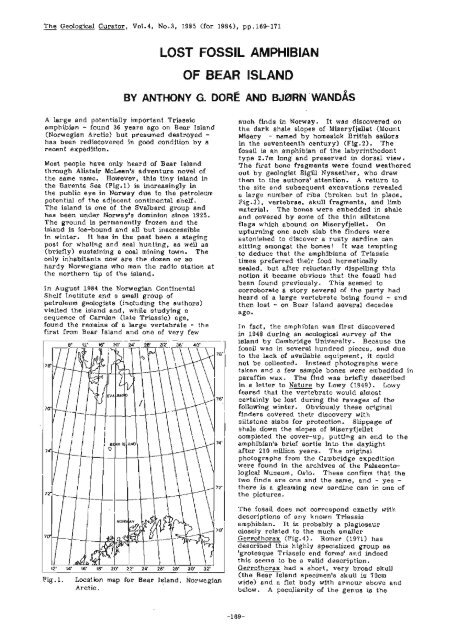Number 3 - Geological Curators Group
Number 3 - Geological Curators Group
Number 3 - Geological Curators Group
You also want an ePaper? Increase the reach of your titles
YUMPU automatically turns print PDFs into web optimized ePapers that Google loves.
-The <strong>Geological</strong> C-,Vo1.4, No.3, 1985 (for 1984). pp.169-171LOST FOSSIL AMPHIBIANOF BEAR ISLANDBY ANTHONY G. DORE AND BJORN WANDASA larne and ootentiallv " imnortant - Triassicamphibian - found 36 years ago on Bear Island(Norwezian Arctic) but presumed destroyed -has been rediscovered in good condition by arecent expedition.Most people have only heard of Bear Islandthrough Alistair McLean's adventure novel ofthe same name. However, this tiny island inthe Barents Sea (Fig.1) is increasingly inthe public eye in Norway due to the petroleumpotential of the adjacent continental shelf.The island is one of the Svalbard group andhas been under Norway's dominion since 1925.The ground is permanently frozen and theisland is ice-bound and all But inaccessiblein winter. It has in the past been a stagingpost for whaling and seal hunting, as well as(briefly) sustaining a coal mining town. Theonly inhabitants now are the dozen or sohardy Norwegians who man the radio station atthe northern tip of the island.In August 1984 the Norwegian ContinentalShelf Institute and a small group ofpetroleum geologists (including the authors)visited the island and, while studying asequence of Carnkn (late Triassic) age,found the remains of a large vertebrate - thefirst from Bear Island and one of very fewFig, l. Location map for Bear Island, NorwegianArctic.such finds in Norway. It was discovered onthe dark shale slopes of Miseryfjellet (MountMisery - named by homesick British sailorsin the seventeenth century) (Fig.2). Thefossil is an amphibian of the labyrinthodonttype 2.7m long and preserved in dorsal view.The first bone fragments were found weatheredout by geologist Eigill Nysaether, who drewthem to the authors' attention. A return tothe site and subsequent excavations revealeda large number of ribs (broken but in place,Fig.31, vertebrae, skull fragments, and limbmaterial. The bones were embedded in shaleand covered by some of the thin siltstoneflags which abound on Miseryfjellet. Onupturning one such slab the finders wereastonished to discover a rusty sardine cansitting amongst the bones! It was temptingto deduce that the amphibians of Triassictimes preferred their food hermeticallysealed, but after reluctantly dispelling thisnotion it became obvious that the fossil hadbeen found previously. This seemed tocorroborate a story several of the party hadheard of a large vertebrate being found - andthen lost - on Bear Island several decadesago.In fact, the amphibian was first discoveredin 1948 during an ecological survey of theisland by Cambridge University. Because thefossil was in several hundred pieces, and dueto the lack of available equipment, it couldnot be collected. Instead photographs weretaken and a few sample bones were embedded inparaffin wax. The find was briefly describedin a letter to Nature by Lowy (1949). Lowyfeared that the vertebrate would almostcertainly be lost during the ravages of thefollowing winter. Obviously these originalfinders covered their discovery withsiltstone slabs for protection. Slippage ofshale down the slopes of Miseryfjelletcompleted the cover-up, putting an end to theamphibian's brief sortie into the daylightafter 210 million years. The originalphotographs from the Cambridge expeditionwere found in the archives of the PalaeontologicalMuseum, Oslo. These confirm that thetwo finds are one and the same, and - yes -there is a gleaming new sardine can in one ofthe pictures.The fossil does not correspond exactly withdescriptions of any known-~riassicamphibian. It is probably a plagiosaurclosely related to the much smallerGerrothorax (Fig.4). Romer (1971) hasdescribed this highly specialized group as'grotesque Triassic end forms' and indeedthis seems to be a valid description.Gerrothorax had a short, very broad skull(the Bear Island specimen's skull is 70cmwide) and a flat body with armour above andbelow. A peculiarity of the genus is the
















